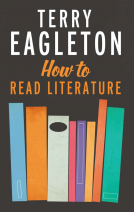
In Terry Eagleton’s slim volume How to Read Literature (Yale University Press, 2013), the author approaches literature like an old friend. His volume is easily readable and quite fun. Rather than didactically explaining how to read literature, he writes with familiarity about different ways one could look at literature. There is no lecture in this volume. There are, however, lots of ideas and inspirations from classic and modern works that Mr. Eagleton himself obviously loves.
How to Read Literature provides just five chapters, yet there is much to be enjoyed in those. First Mr. Eagleton begins by looking at openings in literature. How do novels set the scene and the tone on the first pages? Then he looks at the characters. I loved his discussion of what makes a character round versus stereotyped, as well as what is realistic or not. Are Dickens’ characters all that unique? Following this, Mr. Eagleton examines various ways of portraying narrative in a text. I’m finding that I like it all, from Trollope to Virginia Woolf. From those foundations, the author proceeds to questions of interpretation (chapter 4) and value (chapter 5).
This is not a volume that tells you the “right” way to read a book. but he does give lots of ideas on how one could. That is what I liked the most about How to Read Literature. There are lots of good books out there telling you what to do. Many leave the reader uninspired. But Mr. Eagleton’s volume gives the reader something unique: a desire to go pick up a novel and see what we find in it.
I liked that Mr. Eagleton did not assign value himself, although he did have a dig at Harold Bloom after he discussed Harry Potter. (“There are literary critics who would not consider the Harry Potter novels worth discussing. In their view, they are not of sufficient merit to count as literature.” [page 174]). I liked how he made me think about the books I’ve read and reread and enjoyed more each time I revisited them. Take, for instance, this quote about characters:
Literary figures have no pre-history. …A book is a material object which exists even if nobody picks it up, but this is not true of a text. A text is a pattern of meaning, and patterns of meaning do not lead lives of their own, like snakes or sofas. (page 46)
It is hard for me to remember that. I read Pride and Prejudice thinking of Elizabeth Bennett as a child, then a married woman, before and after the novel. But it is not true. Elizabeth Bennett does not exist beyond the pages. Isn’t marvelous what worlds and characters a great novel can create?
I’m off to read some more literature, invigorated by Mr. Eagleton’s remarks on how one could approach it! His book is highly recommended.
Note: I received a digital review copy of this book from the publisher for review consideration, although I finished reading it via a library copy of the book.




